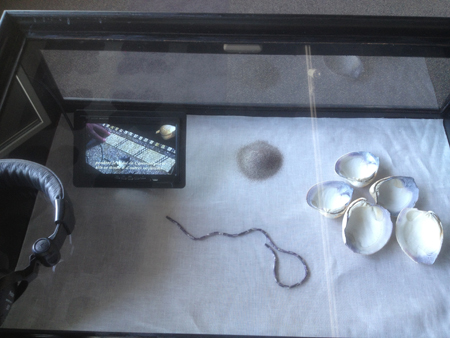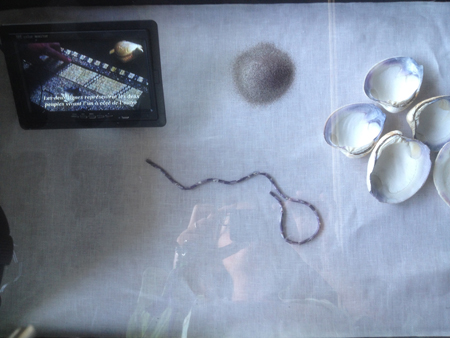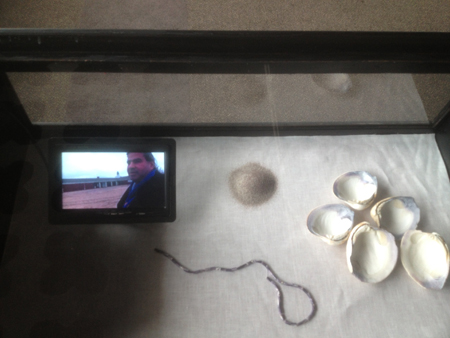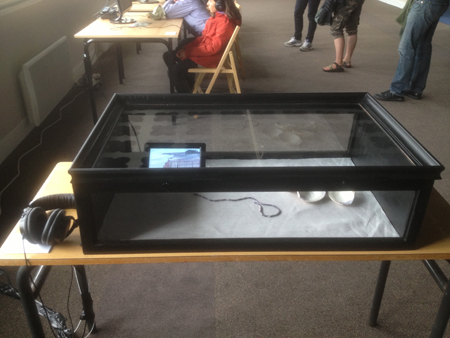Dons coquillages, sable, perles : Harry Wallace (magic wampums) ; faiseur de perles : Gordel
diep~haven/ festival transmanche — Littoral
Espace de la mer, Pourville, crédits photo : Lubin Tree Hunter
Sewan Akey, vidéo 13’
Long Island dans la langue de la tribu Unkechaug à Mastic Shirley se nomme Sewan Akey, ce qui signifie "Land of the black wampum beads" (le territoire des perles de wampum noires).
Le wampum est une ceinture sacrée faite de perles elles même confectionnées avec les coquillages quahog ramassées sur les plages de Long Island, New York. Les wampums portent une valeur symbolique, un message codé : ces objets sont offerts par les amérindiens lors de mariages, baptêmes. Mais ils ont pu également faire office de contrats avec l ‘homme blanc, lors d’un accord de paix ou de guerre. Lorsque les wampums comportent une majorité de perles blanches, ils signifient des contrat de paix et d’amitié. Les wampums à dominante noire sont au contraire des déclarations de guerre. Les ceintures sont gardées précieusement par les chefs de tribus comme objets sacrés que l’on utilise pendant les cérémonies et rituels : objets de mémoire, parole donnée, objet d’identification. Elles furent utilisés pendant longtemps par les hollandais comme monnaie d’échange. Le peuple de la tribu Unkechaug s’identifie pleinement ( ils en portant le nom) aux rivages de Long Island, à ses coquillages et à ses perles. ils en tirent leur économie et leur identité. Harry Wallace, chef de la réserve Poospatuk, raconte ici son attachement au paysage, à la couleur du sable se retrouvant dans les perles. Un parallèle s’établie entre la fonction sociale des wampuns et le rôle naturel des coquillages qui nettoient l’eau : dans les deux cas ils garantissent un équilibre, permettent une communication. la culture des Indiens, ici comme ailleurs est inséparable de l’environnement dans lequel la société s’est développer et évolue.
Long Island is called at Mastic Shirley Sewan Akeyn: which means the land of the black wampum. The wampum is a sacred belt made out of beads that are made out of shells found on the beach of Long Island, New York; the quahogs. The wampum carries a symbolic meaning, a coded message: The object is offered for weddings and funerals. But they can also be contracts with the white man, during agreements of peace or war. When the wampum has a majority of white pearls, it means a treaty of peace and friendship. When it has a majority of black beads, it is a declaration of war. The wampum are kept preciously by chiefs as sacred objects and are used during ceremonies and rituals: objects of memory, object on which you swear, object of identification. They were for a long time used by dutchmen as money and exchange. The people of the Unkechaug tribe identify fully (they carry their name) with the beaches of Long Island, to its shells and beads. They give their economy and their identity. Harry Wallace, chief of the Poospatuk reservation tells us here his attachment to the landscape, to the color of the sand that you find in the beads. A parallel story happens here between the social function of the wampum and the ecological role that it has in the natural system of cleaning the water. In both cases they play a role of balance and regulation. The culture of American Indians, here as elsewhere is deeply linked to the environment where it evolves.




